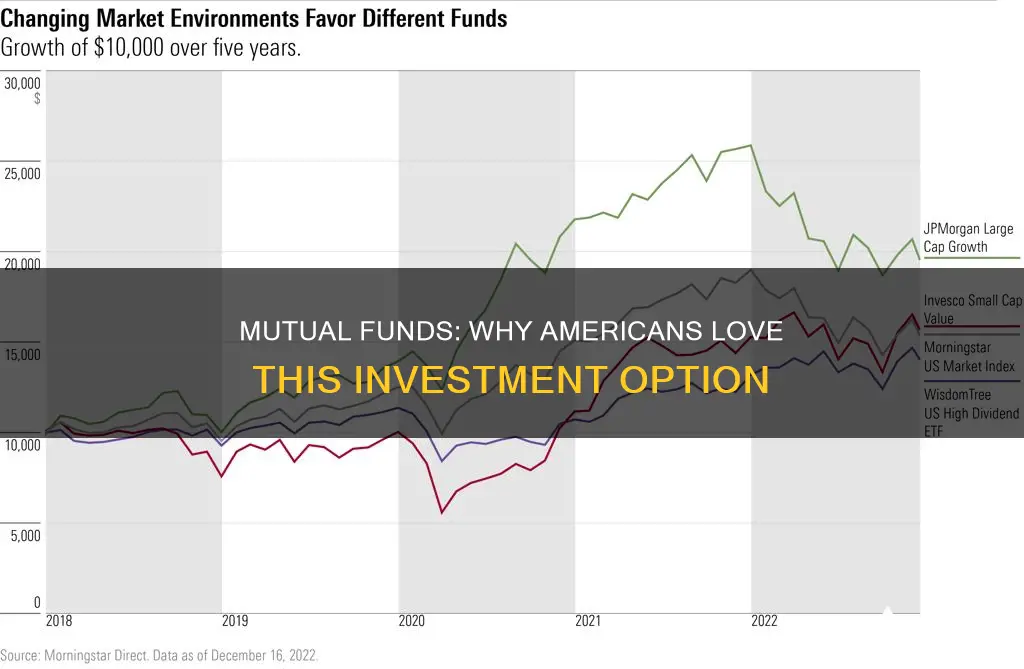
Mutual funds are a popular investment vehicle for Americans, with over half of American households investing in them. They are a type of investment fund that pools money from multiple investors to purchase a diversified portfolio of stocks, bonds, or other securities. This provides individual investors with access to a professionally managed portfolio, allowing them to benefit from economies of scale while spreading their risk across multiple investments. Mutual funds are also popular due to their low minimum investment amounts, making them accessible to most investors. Additionally, they offer automatic diversification, liquidity, and customizability, making them an attractive option for those seeking to build a well-rounded investment portfolio.
What You'll Learn

Low minimum investment amounts
One of the main reasons mutual funds are a popular investment option for Americans is their low minimum investment amounts. While the minimum investment amount varies across different mutual funds, a typical minimum investment is $1,000 to start, with additional investments or redeployments requiring even smaller amounts. Some mutual funds offer $0 minimums, while others require a minimum initial investment of between $500 to $5,000. This accessibility makes mutual funds an attractive option for investors with limited capital, including those from middle-class households.
Mutual funds are also popular due to their automatic diversification, professional management, liquidity, and customizability. They offer investors the opportunity to spread their risk across a variety of investments and are managed by professionals who have the experience to judge the profitability of different investments. Shares in mutual funds can be easily bought and sold due to their high demand and liquidity. The availability of numerous mutual funds catering to different interests and investment needs further contributes to their popularity.
Additionally, mutual funds are often the gateway to investment for Americans, with employer-sponsored retirement plans being a common entry point. Over half of American households had investments in mutual funds in 2023, and they collectively owned 88% of all mutual fund assets. This trend reflects the increasing reliance on mutual funds for retirement savings, particularly among middle-income earners.
Robo Advisors: Index Fund Investing Strategies Explored
You may want to see also

Diversification of investments
Mutual funds are a popular investment vehicle for Americans because they offer an easy way to diversify their portfolios. Diversification is a risk management strategy that involves spreading investments across various assets to reduce the impact of any single negative event. By investing in mutual funds, Americans can gain exposure to a wide range of stocks, bonds, and other securities, which helps to lower the overall risk of their investment portfolio.
- Risk Reduction: The primary benefit of diversification is risk reduction. By investing in a variety of assets through mutual funds, Americans can reduce the impact of any single investment loss on their overall portfolio. This is because the poor performance of one asset may be offset by the positive performance of another. Diversification helps investors avoid putting "all their eggs in one basket," thus providing a level of protection against potential market downturns or individual stock failures.
- Access to a Wide Range of Assets: Mutual funds pool money from multiple investors, allowing individual investors to access a diversified portfolio of assets that may otherwise be difficult or costly to acquire on their own. This is especially beneficial for small investors who can invest in a variety of stocks, bonds, and other securities by purchasing a single mutual fund.
- Professional Management: Mutual funds are managed by professional fund managers who have the expertise and resources to research and select a diverse range of investments. These managers construct well-diversified portfolios, taking into account various factors such as asset allocation, industry exposure, and risk management. This relieves individual investors of the burden of having to research and track numerous investments themselves.
- Lower Minimum Investment: Mutual funds typically have lower minimum investment requirements compared to purchasing individual stocks or bonds. This makes diversification more accessible to a wider range of investors, including those with limited capital.
- Simplicity and Convenience: Investing in mutual funds offers a simple and convenient way to achieve diversification. Instead of having to select and manage multiple investments, investors can rely on the expertise of professional fund managers. This is especially beneficial for those who do not have the time or knowledge to actively manage a diverse portfolio.
By investing in mutual funds, Americans can benefit from diversification, which helps reduce risk, increase access to a wide range of assets, and provide professional management at a lower cost. This makes mutual funds a popular choice for those seeking an easy way to diversify their investment portfolios.
UK Index Funds: Where to Invest Your Money Wisely
You may want to see also

Professional management
One of the main reasons mutual funds are a popular investment choice for Americans is that they offer professional management. This means that investors benefit from the knowledge and experience of fund managers who are tasked with making and monitoring investments. These managers are legally obligated to follow the fund's stated mandate and to work in the best interest of mutual fund shareholders.
Mutual funds are therefore an attractive option for those who don't have the time or knowledge to manage a diversified investment portfolio themselves. They allow investors to benefit from the fund manager's research and skillful trading without having to worry about making changes if one stock does better than another.
Additionally, mutual funds are a relatively inexpensive way for small investors to access professional money management. They typically have low minimum investment requirements, providing a low-cost way for individual investors to experience the benefits of professional management.
Mutual funds are also subject to industry regulations that ensure accountability and fairness for investors. The component securities of each mutual fund can be found across many platforms, providing transparency and allowing investors to research and choose from funds with different management styles and goals.
Mutual funds can be actively or passively managed. Actively managed funds attempt to beat the market by picking stocks that will perform well, while passively managed funds aim to match the performance of a market benchmark. Actively managed funds tend to be more expensive due to the work involved in researching and selecting stocks.
Retirement Planning: Beyond the 401(k) and Emergency Fund
You may want to see also

Liquidity
The high liquidity of mutual funds is due to several factors. Firstly, mutual funds are in high demand, which makes it relatively easy to buy and sell shares. Secondly, mutual funds themselves hold high levels of liquid investments, meaning they can quickly sell off portfolio holdings to enhance their liquidity. Thirdly, mutual funds have regular cash inflows from the proceeds of new fund share purchases, as well as from interest and dividend payments, bond maturations, and prepayments.
Mutual funds must also carefully manage their liquidity to balance the need to meet unanticipated redemption demands with their investment objectives. They do this by maintaining appropriate cash levels and holding other liquid investments. Most funds keep approximately 3% to 5% of their total assets in cash. Liquidity ratios above 5% indicate a bearish market outlook, while ratios below 5% indicate a bullish outlook.
The Securities and Exchange Commission (SEC) has issued rules and regulations regarding mutual fund liquidity management, including limiting "illiquid assets" to 15% of the fund's net assets and requiring funds to document a comprehensive liquidity program. These regulations help ensure that mutual funds remain liquid enough to meet redemption requests and protect the interests of shareholders.
India's Alternative Investment Funds: Exploring the Options
You may want to see also

Customisability
Firstly, mutual funds are highly customisable in terms of their composition. As a pooled investment vehicle, mutual funds are portfolios of stocks, bonds, or other securities, selected in accordance with the fund's stated strategy. This strategy is tailored to different objectives and risk tolerances, allowing investors to choose funds that align with their specific financial goals and comfort levels. The funds are managed by professionals who actively select and monitor the assets within the portfolio to achieve the desired investment outcomes.
Secondly, mutual funds offer customisability in terms of investor involvement. Investors can choose the level of engagement that suits their preferences and expertise. Those who want a more passive approach can rely on the fund managers to make investment decisions on their behalf, benefiting from their expertise and ability to respond to market dynamics. On the other hand, investors who want a more active role can opt for funds that allow them to provide input or collaborate with the fund managers. This customisability ensures that mutual funds can cater to a wide range of investors, from those seeking a hands-off approach to those who want a more active participation in their investment decisions.
Additionally, mutual funds provide flexibility in terms of investment amounts. They typically have low minimum investment requirements, making them accessible to a broad range of investors. This customisability in investment amounts allows individuals to start investing with smaller sums and gradually increase their contributions over time.
The customisability of mutual funds extends beyond the funds themselves and caters to investors' varying levels of involvement, making them a versatile and attractive option for Americans seeking to build their investment portfolios.
Invest in Tesla: Top Mutual Funds to Consider
You may want to see also







